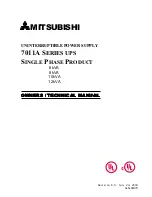
MITSUBISHI ELECTRIC 7011A SERIES UPS
MITSUBISHI
ELECTRIC
7011A SERIES UPS
OWNERS / TECHNICAL MANUAL
Page Number:
viii
CAUTION
PRECAUTIONS FOR MAINTENANCE AND INSPECTION
PRECAUTIONS FOR MAINTENANCE AND INSPECTION
PRECAUTIONS FOR MAINTENANCE AND INSPECTION
PRECAUTIONS FOR MAINTENANCE AND INSPECTION
•
The inside of the UPS must be inspected or repaired only by qualified personnel.
-Failure to observe this could lead to electrical shocks, injuries, burns, smoke generation or
fires.
•
Periodically replace the battery (every 5 years).
-Batteries that have exceeded the replacement life could lead to fires from electrolyte leakage
or fire ignition.
•
Contact the dealer or service company for unit maintenance and repairs, and for the
replacement of defective parts.
-Opening the cover could lead to electrical shocks or burns.
PRECAUTIONS FOR BATTERY
PRECAUTIONS FOR BATTERY
PRECAUTIONS FOR BATTERY
PRECAUTIONS FOR BATTERY
•
If the battery ignites, do not use water to extinguish the fire. Instead, use a powder (ABC)
fire extinguisher.
-Use of water could cause the fire to grow.
•
Toxic diluted sulfuric acid in the battery.
-If electrolyte leaks from the unit, avoid contact with the skin or clothes.
If electrolyte makes contact with the skin or clothes, wash it off thoroughly with clean water.
If electrolyte makes contact with the eyes, rinse immediately and thoroughly with clean water,
and then see a doctor. The presence of sulfuric acid in the eyes could lead to blindness, and
adherence to skin could lead to burns.
OTHER PRECAUTIONS
OTHER PRECAUTIONS
OTHER PRECAUTIONS
OTHER PRECAUTIONS
•
Never use or store the unit in the following types of environment:
a)
A location having a low or high temperature, or high humidity deviated from the ambient
environment conditions described in the brochure or instruction manual.
b)
A location submerged in water or where the unit could become wet from dripping water.
c)
At an altitude higher than 5000 feet (1500 meters).
d)
In direct sunlight.
e)
Where organic solvents (gasoline, paint thinner, etc.) are stored.
f)
A location that is dusty.
g)
A location containing combustible gas, corrosive gas, salt or oil mist.
h)
A location subject to vibration or impacts.
i)
A location near devices that generate sparks or near heating elements.










































